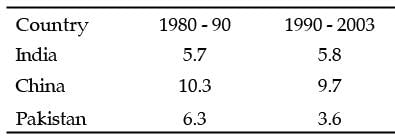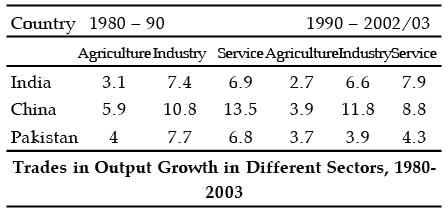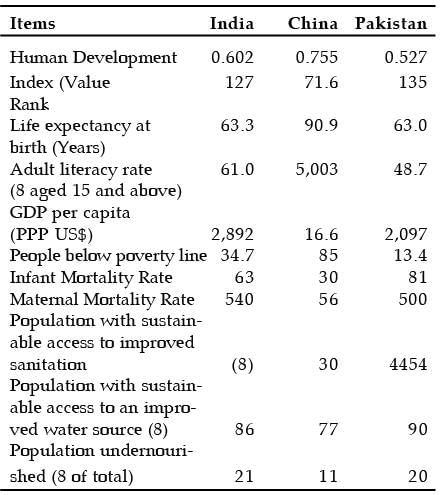NCERT Summary: India’s Economic Interaction with the World- 2 | Indian Economy for UPSC CSE PDF Download
GROSS DOMESTIC PRODUCT AND SECTORS.
One of the much talked issues around the world about China is its growth of Gross Domestic Product China has the second largest GDP (PPP) of $7.2 trillion whereas India's GDP (PPP) is $3.3 trillion and Pakistan's GDP is roughly about 10 per cent of India's GDP.

Growth of Gross Domestic Products (%), 1980 - 2003
When many developed countries were finding it difficult to maintain a growth rate of even 5 per cent, China was able to maintain near double- digit growth for more than two decades. Also notice that in the 1980s Pakistan was ahead of India, China was having double digit growth and India was at the bottom. In the 1990s, there is a marginal decline in India and China's growth rates whereas Pakistan met with drastic decline at 3.6 cent. Some scholars hold the reform processes introduced in 1988 in Pakistan and political instability as the reason behind this trend.
First, look at how people engaged in different sectors contribute to Gross Domestic Product. China and Pakistan have more proportion of urban people than India. In China, due to topographic and climatic conditions, the area suitable for cultivation is relatively small - only about 10 per cent of its total land area. The total cultivable area in Chain accounts for 40 per cent of the cultivable area in India. Until the 1980s, more than 80 per cent of the people in China were dependent on farming as their sole source of livelihood. Since then, the government encouraged people to leave their field and pursue other activities such as handicrafts, commerce and transport. In 2000, with 54 per cent of its workforce engaged I agriculture, its contribution to GPD in china is 115 per cent.
In both India and Pakistan, the contribution of agriculture to GPD is the same, at 23 per cent, but the proportion of workforce that works in this sector is more in India. In Pakistan, about 49 per cent of people work in agriculture whereas in India it is 60 per cent. The sectoral share of output and employment also shows that in all the three economies, the industry and service sectors have less proportion of workforce but contribute more in terms of output. In china, manufacturing contributes the highest to GPD at 53 per cent whereas in India and Pakistan, it is the service sector, which contributes the highest. In both these countries, services sector accounts for more than 50 per cent of GPD.
In the normal course of development, countries first shift their employment and output form agriculture to manufacturing and then to service. This is what is happening in china. The proportion of workforce engaged in manufacturing in India and Pakistan were low at 16 and 18 per cent respectively. The contribution of industries to GPD is also just equal to or marginally higher than the output form agriculture. In India and Pakistan, the shift is taking place directly to the service sector.
Thus, in both India and Pakistan, the service sector is emerging as a major player of development. It contributes more to GPD and, at the same time, emerging as a prospective employer. If we look at the proportion of workforce in the 1980s, India and Pakistan was faster in shifting its workforce to service sector respectively. In 2000, it has reached the level of 24, 19 and 37 per cent respectively. In the last tow decades, the growth of agriculture sector, which employs the largest proportion of workforce in all the three countries, has declined. In the industrial sector, china has maintained a double - digit growth rate whereas for India and Pakistan growth rate has declined. In the case of service sector, India has been able to raise its rate of growth in the 1990s while china and Pakistan has shows deceleration in all the three sectors.
 INDICATORS OF HUMAN DEVELOPMENT
INDICATORS OF HUMAN DEVELOPMENT
If we compare the indices given in the table you will find that china is moving ahead of India and Pakistan. This is true for many indicators - income indicator such as GPD per capita, or proportion of population below poverty line or health indicators such as mortality rates, access to sanitation, literacy, life expectancy or malnourishment. Pakistan is ahead of India in reducing proportion of people below the poverty line and also its performance in education, sanitation and access to water is better than India. But neither of these tow countries have been able to save women from maternal mortality. In china, for one lakh births, only 50 women die whereas in India and Pakistan, more than 500 women die. Surprisingly India and Pakistan are ahead of china in providing improved water sources. You will notice that for the proportion of people below the international poverty rate of $1 a day, both china and Pakistan are in similar position whereas the proportion is almost two times higher for India.
 Some Select Indicators of Human Development, 2003
Some Select Indicators of Human Development, 2003
In dealing with or making judgments on such question, however, we should also note a problem with using the human development indicators given above with conviction. This occurs because these are all extremely important indicators: but these are not sufficient. Along with these, we also need what may be called 'liberty indicators'. One such indicator has actually been added as a measure of 'the extent of democratic participation in socially and politically decision mankind' but it has not been given any extra weight. Some obvious 'liberty indicators' like measures of the extent of constitutional protection given to rights of citizens ' or the 'extent of constitutional protection of the independence of the judiciary and the rule of law' have not even been introduced so far. Without including these (and perhaps some more) and giving them overriding importance in the list, the construction of a human development index may be said to be incomplete and its usefulness limited.
DEVELOPMENT STRATEGIES- AN APPRAISAL
It is common to find developmental strategies of country as a model to other for lessons and guidance for their own development. It is particularly evident after the introduction of the reform process indifferent parts of the world. In order to learn from economic performance of our neighboring countries, it is necessary to have an understanding of the roots of their successes and failures. It is also necessary to distinguish between, and contrast, the different of their strategies. Though different countries go though their development phases differently, let us take the ignition of reforms as a point of reference. We know that reforms were initiated in China in 1978, Pakistan in 1988 and India in 1991. Let us briefly assess their achievements and failures in pre and post reform periods.
Why did China introduce structural reforms in 1978? China did not have any compulsion to introduce reforms as dictated by the World Bank and International Monetary Fund to India and Pakistan. The new leadership at that time in China was not happy with the slow pace of growth and lack of modernization in the Chinese economy under the Maoist rule. They felt that Maoist vision of economic development based on decentralization, self-sufficiency and shunning of foreign technology, goods and capital has failed. Despite extensive land reforms, collectivization, the Great Leap Forward and other initiatives, the per capita grain output in 1978 was the same as it was in the mid- 1950s.
It was found that establishment of infrastructure in the areas of education and health, land reforms, long existence of decentralized planning and existence of small enterprises had helped positively in improving the social and income indicators in the post reform period. Before the introduction of reform, there had already been massive extension of basic health services in rural areas. Though the commune system, there was more equitable distribution of food grains. Experts also point out that each reform; measure was first implemented at a smaller level and then extended on a massive scale. The experimentation under decentralized government enabled to assess the economic, social and political costs of success or failure. For instance, when reforms were made in agriculture, as pointed out earlier by handing over plots of land to individuals for cultivation, it brought prosperity to a vast number of poor people. It created conditions for the subsequent phenomenal growth in rural industries and built up a strong support base for more reforms. Scholars quote many such examples on how reform measures let to rapid growth in China.
Though the data on international poverty line for Pakistan is quite healthy, scholars using the official data of Pakistan indicate rising poverty there. The proportion of poor in 1960s was more than 40 per cent which declined to 25 per cent in 1980s and started rising again in 1960s. The reasons for the slow-down of growth and re-emergence of poverty in Pakistan's economy, as scholars put it. Are (i) agricultural growth and food supply situation were base not on an instituonalised process of technical change but on good harvest. When there was a good harvest, the economy was in good condition, when it was not, the economic indicators showed stagnation or negative trends you will recall that India had to borrow from the IMF and World Bank to set right its balance of payment crisis: foreign exchange is an essential component for any country and it is important to know how it can be earned. If a country is able to build up its foreign exchange earnings by sustainable export of manufactured goods, it need not worry. In Pakistan most foreign exchange earnings came from remittances from Pakistani workers in the Middle-east and the export of highly volatile agricultural products: there was also growing dependence on foreign loans on the one hand and increasing difficulty in paying back the loans on the other. However, as stated in the 'One Year Performance of the (Pakistan) Government' for the year August 2004-2005, the Pakistan economy has been witnessing GDP growth at about 8 percent for three consecutive years = (2002-2005). All the three sectors, agriculture, manufacturing and service, have contributed to this trend. Besides facing high rates of inflation and rapid privatisation, the government is increasing the expenditure on various areas that can reduce poverty.
CONCLUSION
What are we learning from the developmental experiences of our neighbors? India, China and Pakistan have traveled more than five decades of development path with varied results. Till the late 1970s, all of them were maintaining the same level of low development. The last three decades have taken these countries to different levels. India, with democratic institutions, performed moderately, but a majority of its people still depends on agriculture. Infrastructure is lacking in many parts of the country. It is yet to raise the level of living of more than one-fourth of its population that lives below the poverty line. Scholars are of the opinion that political instability, overdependence on remittances and foreign aid along with volatile performance of agriculture sector are the reasons for the slowdown of the Pakistan economy. Yet, in the recent past, it is hoping to improve the situation by maintaining high rates of GDP growth. It is also a great challenge for Pakistan to recover from the devastating earthquake in 2005, which took the lives of nearly 75,000 people and also resulted in enormous loss to property. In china, the lack of political freedom and its implications for human rights are major concerns; yet, in the last three decades, it used the 'market system without losing political commitment' and succeeded in raising the level of growth along with alleviation of poverty. Unlike India and Pakistan, which are attempting to privatize their public sector enterprises, China has used the market mechanism to 'create additional social and economic opportunities'. By retaining collective ownership of land and allowing individuals to cultivate lands, China has ensured social security in rural areas. Public intervention in providing social infrastructure even prior to reforms has brought about positive results in human development indication in China.
|
107 videos|311 docs|135 tests
|
FAQs on NCERT Summary: India’s Economic Interaction with the World- 2 - Indian Economy for UPSC CSE
| 1. How has India's economic interaction with the world changed over time? |  |
| 2. What are the major sectors where India has economic interactions with the world? |  |
| 3. How does India's economic interaction with the world impact its domestic economy? |  |
| 4. What are some of the key factors that have influenced India's economic interaction with the world? |  |
| 5. How does India's economic interaction with the world contribute to its overall development? |  |

|
Explore Courses for UPSC exam
|

|

















